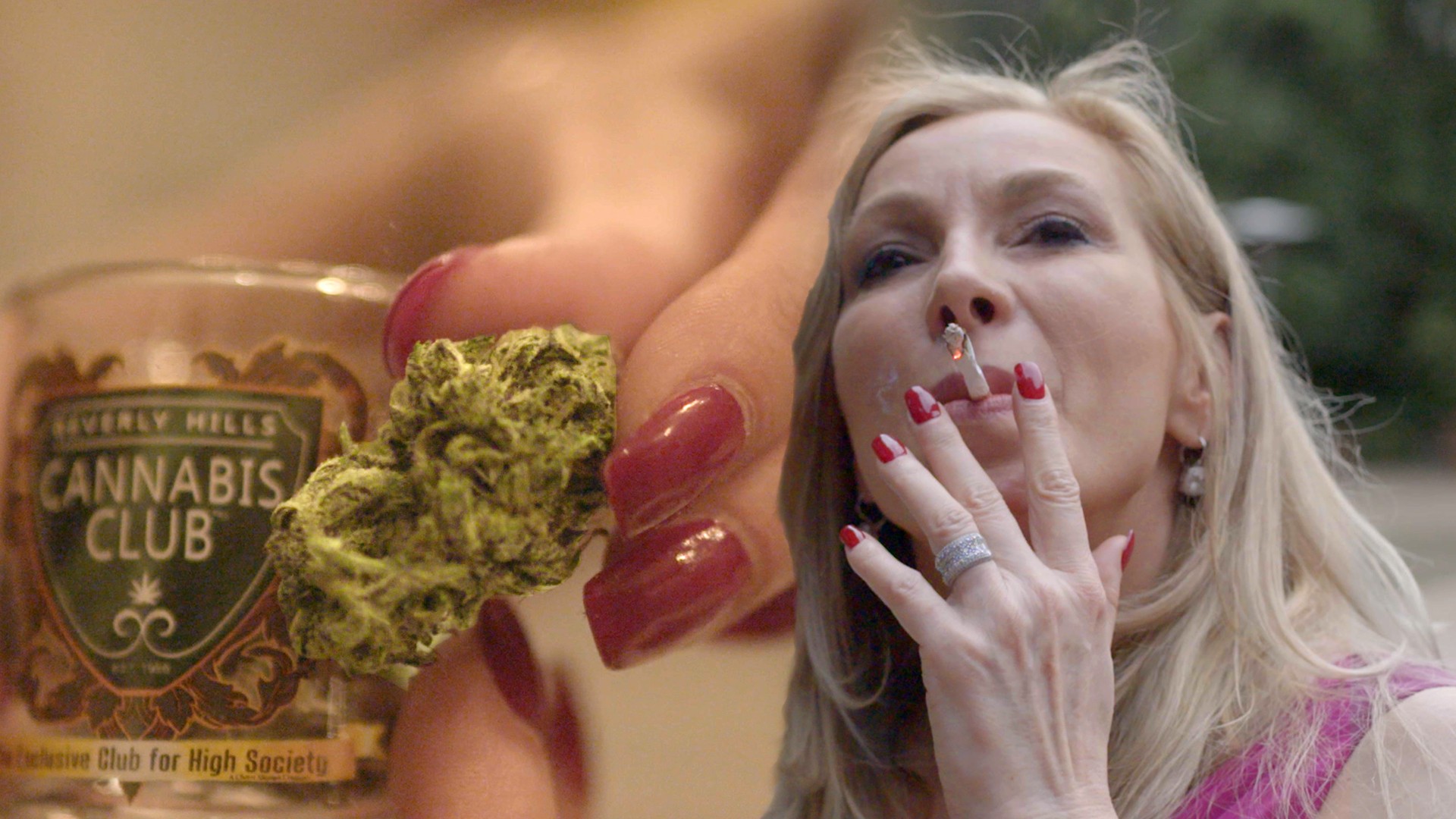Illustration by Lia Kantrowitz.
In 1949, LIFE ran a photo essay about ranching in the American West that featured a cowboy named Clarence Hailey Long. Pictured in a ten-gallon Stetson hat with a pouch of tobacco hanging out of his front pocket, the 39-year-old Texan was the post-war ideal of masculinity. When Chicago advertising executive Leo Burnett saw the photo essay, he also saw a way to market filtered cigarettes—at the time considered feminine—to men. Starting in 1954, Long served as the inspiration for a series of smoking, smoldering Marlboro Men, the stars of a revolutionary campaign that made the previously obscure brand's sales jump more than 3,000 percent in one year.Cigarette ads have been banned from television since 1971, and as a condition of a class action settlement against major tobacco companies in the late 90s, mascots like the Marlboro Man were out, too. Meanwhile, young people today watch two and a half times more internet content than TV. That means they'd be more likely to hear about a new product on YouTube than television. And while YouTube does run more traditional ads before user-created videos, brands also pay YouTube stars to review their products. One creator currently profiting off this arrangement is Donny Karle, who reviews vaping products under the handle DonnySmokes.Although he's far from rugged looking, with his penchant for colorful tank tops and wiry frame, you might call Karle the Marlboro Man of the digital era. The 21-year-old's first hit off a vape came as a college freshman when a friend passed him an e-cigarette en route to class. Soon after, he was carrying a heavy rig that weighed down his pants, leaked nicotine juice everywhere, and caused his boss to yell at him when he blew thick clouds at work. So on May 4, 2017, he purchased a much slimmer and inconspicuous e-cigarette called the JUUL. He also decided to film an unboxing video—his first-ever foray into the medium—and share six minutes' worth of thoughts."My goal is to stop vaping, because I really don't wanna vape," he says in the review. "I just want something that's cheaper that I can hit less." However, that plan was apparently foiled when the unboxing video racked up an impressive 52,000 views, which caused Karle to keep creating more vaping content under the handle. In less than a year, he's racked up almost 120,000 subscribers on his channel, where he posts videos multiple times per week. Although his original plan was to quit vaping, smoking on camera has become his full-time job. It all became more of a business than a hobby when Karle reached about 1,000 followers. That's when he was able to leverage his platform to get free swag from certain vape companies. But comped nicotine juice is not the main draw here. DonnySmokes gets about 3 million views per month, which he says translates to an income of about $1,200 from YouTube. But much more lucrative is the fact that he also charges any company that wants a review a flat fee. According to Karle, he gets between four and six emails a day from people seeking reviews, and the money he makes from the companies whose products he reviews amounts to more than he'd make if he'd gotten a more traditional job in business. And although he got his start posting "sesh" and troubleshooting videos focusing on one particular product, Karle says his profile is such that he'll no longer work for free."I know for a fact that JUUL is way too cheap to pay what I charge for a review," he bragged to me over the phone, audibly exhaling from a vape. "I don’t like to get into the specifics of [money], especially when I’m being recorded. But I’m not doing bad at all, so don’t think these companies are getting the best of me."Whether he knows it or not, the fact that Karle gets paid for any of his videos puts him in the middle of a debate that much older media professionals have been trying to settle for years. Even if you don't know the term "native advertising," you know the concept. Think sponsored posts that appear on your Twitter or Facebook feeds, which are integrated seamlessly into the stream, and only read as product plugs if you're paying close attention. The Federal Trade Commission has had a difficult time regulating the practice, because it hasn't come up with a clear set of guidelines that media companies should follow, according to a 2015 academic journal article written by Brandon Einstein called "Reading Between the Lines." Basically, he argues, the marketing strategy's effectiveness comes from inadvertent "deception," or the fact that consumers who think they are news savvy actually have a difficult time telling the difference between, say, a music review and an advertisement for Buick. YouTube told me in a statement that content creators are responsible for policing themselves, which means verbally acknowledging that they're engaging in paid promotion. However, the idea of all the rule-breakers getting caught is laughable, given the sheer amount of content being generated by the site.Teens in particular seem to have a shaky handle on the concept of native advertising. When Stanford researchers showed 203 middle schoolers an example of it on Slate.com as part of a 2016 study, a whopping 80 percent of them believed it was just another article despite it being labeled as sponsored content. This is particularly worrying because several of Karle's videos suggest that he's catering to a very young crowd. "How to HIDE & HIT Your JUUL at SCHOOL WITHOUT Getting CAUGHT," for instance, is only useful or interesting to minors. "[A]nybody have any tips on how to order a juul without parents finding out?" reads one comment. (YouTube flagged the video with a warning in January for being "inappropriate or offensive to some audiences.") Another video, which isn't age-gated or flagged, gives tips on how to hide your JUUL from parents.
It all became more of a business than a hobby when Karle reached about 1,000 followers. That's when he was able to leverage his platform to get free swag from certain vape companies. But comped nicotine juice is not the main draw here. DonnySmokes gets about 3 million views per month, which he says translates to an income of about $1,200 from YouTube. But much more lucrative is the fact that he also charges any company that wants a review a flat fee. According to Karle, he gets between four and six emails a day from people seeking reviews, and the money he makes from the companies whose products he reviews amounts to more than he'd make if he'd gotten a more traditional job in business. And although he got his start posting "sesh" and troubleshooting videos focusing on one particular product, Karle says his profile is such that he'll no longer work for free."I know for a fact that JUUL is way too cheap to pay what I charge for a review," he bragged to me over the phone, audibly exhaling from a vape. "I don’t like to get into the specifics of [money], especially when I’m being recorded. But I’m not doing bad at all, so don’t think these companies are getting the best of me."Whether he knows it or not, the fact that Karle gets paid for any of his videos puts him in the middle of a debate that much older media professionals have been trying to settle for years. Even if you don't know the term "native advertising," you know the concept. Think sponsored posts that appear on your Twitter or Facebook feeds, which are integrated seamlessly into the stream, and only read as product plugs if you're paying close attention. The Federal Trade Commission has had a difficult time regulating the practice, because it hasn't come up with a clear set of guidelines that media companies should follow, according to a 2015 academic journal article written by Brandon Einstein called "Reading Between the Lines." Basically, he argues, the marketing strategy's effectiveness comes from inadvertent "deception," or the fact that consumers who think they are news savvy actually have a difficult time telling the difference between, say, a music review and an advertisement for Buick. YouTube told me in a statement that content creators are responsible for policing themselves, which means verbally acknowledging that they're engaging in paid promotion. However, the idea of all the rule-breakers getting caught is laughable, given the sheer amount of content being generated by the site.Teens in particular seem to have a shaky handle on the concept of native advertising. When Stanford researchers showed 203 middle schoolers an example of it on Slate.com as part of a 2016 study, a whopping 80 percent of them believed it was just another article despite it being labeled as sponsored content. This is particularly worrying because several of Karle's videos suggest that he's catering to a very young crowd. "How to HIDE & HIT Your JUUL at SCHOOL WITHOUT Getting CAUGHT," for instance, is only useful or interesting to minors. "[A]nybody have any tips on how to order a juul without parents finding out?" reads one comment. (YouTube flagged the video with a warning in January for being "inappropriate or offensive to some audiences.") Another video, which isn't age-gated or flagged, gives tips on how to hide your JUUL from parents.
Advertisement
Advertisement

Advertisement
Granted, the distinction between a review and a commercial is sometimes a bit murky. You wouldn't consider a positive New York Times movie review an advertisement, for instance, though it's obviously encouraging people to spend money on a movie ticket. Meanwhile, despite the fact that Karle's vape reviews tend to skew on the positive side, he said that the companies sending him free products don't get pre-approval on his videos. Michael Tolmach, the co-founder and CEO of the vape company Eonsmoke, corroborated that claim. "He's incredibly selective, and even if you pay him, he may not review your products if you are not relevant," he told me. "He also warned us that if the products are garbage, then he will review them as such. No guarantees. Welcome to DonnySmokes." While Karle refused to disclose how much companies pay him for reviewing their products, Tolmach told me Eonsmoke pays $1000 a pop.The fact that Karle is getting paid by the brands themselves for his reviews—something that he doesn't advertise—constitutes a conflict of interest that overwhelms any overtures he might make toward something like journalistic objectivity. "It depends if you ask what the word 'advertising' means to you and how you think about that," says Anne Tuchman, a marketing professor who studies e-cigarettes at Northwestern University. "I would say this sounds like a classic example of native advertising."
Advertisement
"There’s not a single chance in the world that somehow all kids in the world are gonna stop vaping or smoking cigarettes," Karle told me. "I’m not trying to say that as a minor, you shouldn’t be doing this, or something like that. I’m here to say, ‘Here’s a safer alternative, and I don’t have any opinions on underage vaping or anything like that.’ It’s not something I’m promoting, and it’s not something I’m saying you shouldn’t do. I don’t have an opinion on it at all. People ask me that a lot, what are your opinions on it. My opinion is simply: I don’t have one."To be sure, there is a difference between a traditional media organization engaging in native advertising and the relatively DIY, small-scale operation Karle is running. But as YouTube and streaming sites take the place of television in terms of reaching young people, it might be worth considering pushing for more clear definitions of what counts as native advertising on platforms like YouTube, as well as whether or not it's responsible for the site's stars to help promote products like vapes in videos aimed at kids.
Sign up for our newsletter to get the best of VICE delivered to your inbox daily.Follow Allie Conti on Twitter.

